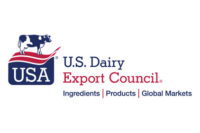The world discovers U.S. dairy ingredients. Exports rise 20%.






U.S. dairy exports, by value, are on track to top $6.5 billion in 2013 — another record, and up more than 25% from the year before. And while it’s tempting to call this year exceptional, that wouldn’t be the case. Over the last decade, the value of U.S. dairy exports has increased, on average, 20% per year.
If U.S. dairy exports were a mutual fund, it would get a five-star rating. A 25% gain? This would be the sixth time in the last 10 years.
After a heavy, two-year supply surge — a surge that was gobbled up all along by robust global demand — milk production expansion among the world’s major exporters came to a halt in August 2012. In March 2013, when a major drought cut New Zealand’s season short, global milk powder prices jumped more than 50% in a matter of weeks. Prices pulled back after the initial frenzy, but remarkably firmed again in the third quarter.
Read the entire Industry Outlook
“We are amidst an unprecedented period of high pricing in terms of level and duration,” stated Rabobank in its September Dairy Quarterly.
In the first three quarters of the year, international benchmark prices for milk powder were up about 40% versus a year ago. Cheese, butterfat and whey were each up 10% to 20%. In the international arena, U.S. products, by comparison, have been a good bargain.
Of course, it was more than just New Zealand farmers who saw production declines. Other major suppliers also provided less milk. In the 12 months ended July 2013, milk production in the European Union, United States, New Zealand, Australia and Argentina was 267.8 million tons, down 1.2% (3.4 million tons) from the year before. This left the market undersupplied, but it also presented the United States with an excellent opportunity. Among the world’s leading exporters, the United States was the only one to increase production in the first half of 2013 (when adjusted for leap day in 2012).
Meanwhile, global demand has been solid in 2013, led by China and Russia, the world’s top two dairy buyers. China’s purchases of milk powder, whey, cheese and butterfat were up 16% this year (through August), while Russia’s imports were up 20% (through July). This has offset more cautious buying from other major importers, such as Southeast Asia, Mexico, Japan and Algeria, where import volumes have been steady in the face of higher prices.
Gaining share
This combination of favorable conditions — supply declines from all our major competitors, good world demand, world prices higher than U.S. prices, continued commitment from U.S. suppliers — has enabled U.S. suppliers to gain share in 2013. Among the top nine exporters (the above-named five, plus Belarus, Uruguay, Switzerland and Ukraine), U.S. export share of milk powder, cheese, butterfat and whey reached 18.4% in the first half of the year, up 2.3 points from the 2012 total. SMP share was 30% (up 4.4 points) and cheese share was 15.6% (up 0.8 points).
Moreover, we’ve gotten stronger as the year has gone on. In the May-July period, U.S. exports by volume were up 20% versus the prior year, while New Zealand, Australia and the EU were down 25%, 20% and 8%, respectively.
As exports have blossomed, they’ve come to represent a larger share of U.S. milk production. In the first seven months of the year, 15.2% of U.S. milk production (on a total-solids basis) has been shipped overseas, compared with an average of 13.1% in 2010 to 2012.
Bullish outlook
At this writing, the outlook for the global dairy markets remains bullish through year-end, at least. Inventories are still light — both at the manufacturer level and the user level. Buyers aren’t purchasing too far ahead and need to stay in the market for coverage.
Besides China and Russia, “low stocks and pent-up demand in other import regions have set the scene for vigorous competition for imports through the balance of 2013, and likely into early 2014,” Rabobank stated.
In addition, the forward curve on Global Dairy Trade auction prices is relatively flat into first quarter 2014, and Fonterra raised its 2013/14 payout forecast three times in the third quarter, suggesting they believe prices will remain high throughout their marketing year. European processors are paying near-record milk prices as well, on the expectation for firm end-product pricing.
“The prospect of any significant softening in world prices will be delayed, possibly until Q2 2014,” according to Rabobank.
In addition, even as the global market cycles lower, the price floor is likely higher than in previous years — a combination of higher costs of production and emerging-market buyers’ willingness to pay more.
“Accumulated demand amongst second-tier importers and an improving global economy may even ensure a soft landing for prices,” concluded Rabobank.
In this environment, U.S. suppliers will have to build on this year’s success to retain progress made in 2014.
Looking for a reprint of this article?
From high-res PDFs to custom plaques, order your copy today!












